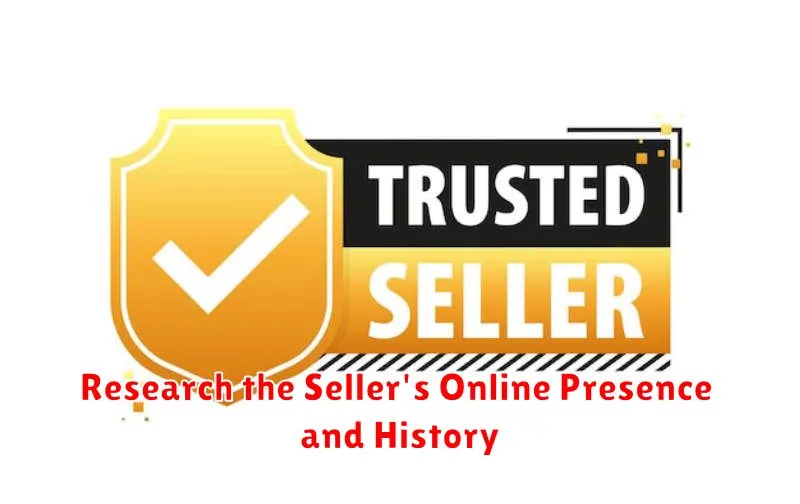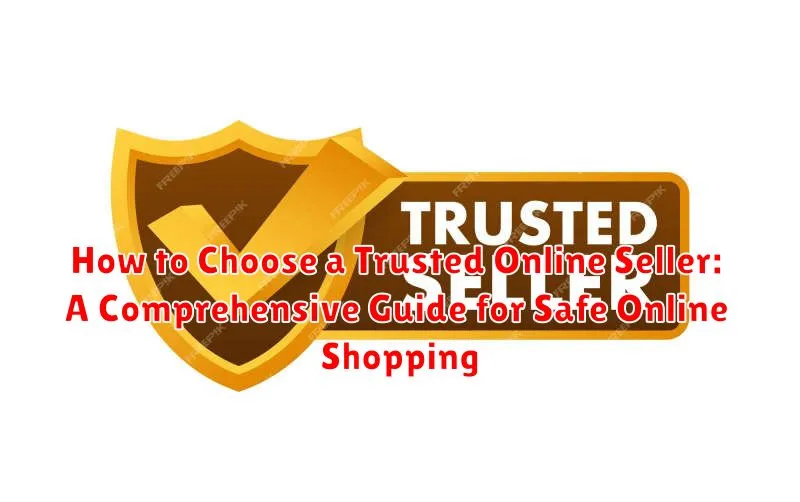In today’s digital marketplace, online shopping offers unparalleled convenience and access to a vast array of products. However, with the ease of online transactions comes the crucial responsibility of identifying trusted online sellers. This comprehensive guide provides a practical framework to navigate the complexities of online shopping securely, enabling you to confidently choose reputable online sellers and avoid potential scams. Learning how to identify trusted sellers is paramount to a positive online shopping experience, protecting you from fraud and ensuring you receive genuine products.
Choosing a trusted online seller involves careful consideration of several factors, from verifying security measures to evaluating customer reviews. This guide will delve into the essential steps for identifying reliable online sellers, offering practical tips and insights for safe online shopping. By understanding the key indicators of trustworthiness, you can make informed decisions and enjoy the benefits of online shopping with peace of mind. This guide will equip you with the knowledge to choose trusted sellers and make your online shopping experience safe, secure, and enjoyable.
Check for Secure Website Connections (HTTPS)
One of the most crucial steps in ensuring safe online shopping is verifying the website’s security. A secure website uses HTTPS (Hypertext Transfer Protocol Secure), indicated by a padlock icon in the address bar. This signifies that the connection between your browser and the website is encrypted, protecting your sensitive information like credit card details and passwords from interception.
Always look for the padlock icon and ensure the website address begins with “https://” rather than just “http://”. The “s” stands for secure and signifies the presence of an SSL (Secure Sockets Layer) certificate. This certificate authenticates the website’s identity and encrypts data transmitted between you and the website.
Be wary of websites lacking this security feature. Never enter personal or financial information on a website without HTTPS. A website without HTTPS puts you at risk of having your data stolen by malicious actors.
Look for Contact Information and Transparency
A trustworthy online seller should provide clear and accessible contact information. Look for a physical address, phone number, and email address. A legitimate business will be transparent about its location and how to reach them.
Beyond basic contact details, assess the seller’s overall transparency. Do they offer detailed information about their products or services? Is their about us section informative and professional? Transparency builds trust and allows you to make informed purchasing decisions. A lack of readily available information can be a red flag.
Consider whether the seller provides information about their business practices, such as shipping methods and handling times. Transparent sellers are upfront about potential delays or issues that may arise during the order fulfillment process. Look for clear and concise terms and conditions, including details about privacy policies.
Scrutinize Seller Reviews and Ratings
Seller reviews and ratings offer valuable insights into the experiences of previous customers. Take the time to thoroughly examine these, paying attention to both the positive and negative feedback.
Don’t just focus on the star ratings. Delve into the written reviews to understand the specific aspects of the seller’s performance that customers praised or criticized. Look for patterns in the feedback. Are there multiple mentions of slow shipping, poor communication, or product misrepresentations? These recurring themes can be red flags.
Be aware that some reviews may be fabricated. Look for signs of authenticity, such as detailed descriptions of the product and buying experience. Generic reviews, overly enthusiastic praise, or numerous identical reviews might be suspicious. Consider using third-party review platforms for a more objective perspective.
Consider the volume of reviews. A high number of positive reviews generally indicates a reliable seller. However, even established sellers can have occasional negative feedback. A few negative reviews amidst a sea of positive ones are not necessarily cause for alarm, especially if the seller has responded appropriately and addressed the customer’s concerns.
Read the Seller’s Return and Refund Policies
A trustworthy online seller will have clear and accessible return and refund policies. Thoroughly review these policies before making a purchase. Understanding the terms and conditions related to returns and refunds can save you from potential headaches later.
Look for specifics like the return window timeframe (e.g., 30 days, 60 days), who pays for return shipping (buyer or seller), and what conditions qualify for a return (e.g., damaged items, incorrect items, simply changing your mind).
A clearly defined policy demonstrates the seller’s commitment to customer satisfaction and provides recourse if the product doesn’t meet your expectations or arrives in unsatisfactory condition. A vague or nonexistent return policy is a significant red flag and should make you reconsider buying from that seller.
Verify Seller Identity Through Social Media and Forums
A legitimate online seller often maintains a presence on social media platforms and relevant online forums. Checking these platforms can provide valuable insights into their authenticity and reputation. Look for established accounts with consistent activity and engagement.
Social Media Presence: Does the seller have a Facebook page, Instagram profile, or Twitter account? A robust social media presence can indicate a commitment to customer interaction and transparency. Look for genuine engagement with followers, including responses to comments and questions.
Forum Participation: Active participation in relevant online forums, especially those related to the products they sell, demonstrates expertise and builds trust. Search for mentions of the seller in industry-specific forums or online communities. Positive discussions and helpful contributions can be a good sign.
Consistency: Does the information presented on social media and forums align with the information on their website? Inconsistencies or discrepancies could be a red flag.
Be Wary of Prices That Are Too Good to Be True

One of the most obvious red flags when shopping online is an unbelievably low price. If a deal seems too good to be true, it probably is. Counterfeit goods, gray market items, or outright scams often lure buyers in with significantly discounted prices. Exercise caution and compare prices across multiple reputable sellers before making a purchase. A drastically lower price compared to the market average should raise immediate suspicion.
Consider these questions when evaluating prices:
- Is the price significantly lower than other sellers?
- Is the discount unusually high, even during a sale period?
- Does the seller offer a clear explanation for the low price?
If you have doubts about the legitimacy of a low price, it’s best to err on the side of caution and look for a more reputable seller with a price that aligns with market standards. Prioritize the security of your purchase over the allure of a seemingly unbeatable bargain.
Consider Using Secure Payment Methods
When shopping online, prioritize secure payment methods that offer buyer protection. Using a credit card is often recommended, as it provides strong fraud protection and the ability to dispute charges if something goes wrong. Many credit card companies offer purchase protection against damage or theft.
Avoid using debit cards directly, as they link directly to your bank account and offer less protection if your information is compromised. Consider using a digital wallet service. These services often encrypt your payment information and can add an extra layer of security. Look for services that offer two-factor authentication.
Be wary of sellers who only accept unconventional payment methods like wire transfers, money orders, or cryptocurrency, especially for larger purchases. These methods offer little to no recourse if the transaction goes awry.
Check Seller Guarantees and Warranties
A reputable online seller should stand behind their products and services. Thoroughly review the seller’s guarantees and warranties before making a purchase. A clear and comprehensive return policy demonstrates confidence in the product’s quality and a commitment to customer satisfaction.
Look for specifics within the guarantee, such as the duration of the coverage, what types of defects are covered, and the process for returns or exchanges. Pay attention to any limitations or exclusions in the warranty. A seller who is transparent about these details is more likely to be trustworthy.
Consider the following when evaluating guarantees and warranties:
- Return Period: How long do you have to return a product if it’s defective or doesn’t meet your expectations?
- Refund Policy: Will you receive a full refund, store credit, or an exchange?
- Shipping Costs: Who is responsible for the cost of return shipping?
- Warranty Period: How long is the product covered for defects after the purchase date?
Research the Seller’s Online Presence and History

A reputable online seller will have a noticeable and established online presence. Investigate their website. Is it professional and easy to navigate? Does it provide clear contact information, including a physical address? A legitimate business typically invests in a well-designed and functional website.
Look beyond the seller’s website. Search for the seller’s name on search engines and social media platforms. What are other customers saying about their experiences? Pay attention to reviews on independent platforms, not just testimonials on the seller’s own website. Be wary of sellers with overwhelmingly positive reviews, as some may be fabricated.
Check how long the seller has been in business. A longer track record often indicates greater stability and reliability. While newer businesses can be legitimate, those with a history of positive customer interactions generally offer more assurance. Look for mentions of the seller on business directories and review sites to verify their history.

